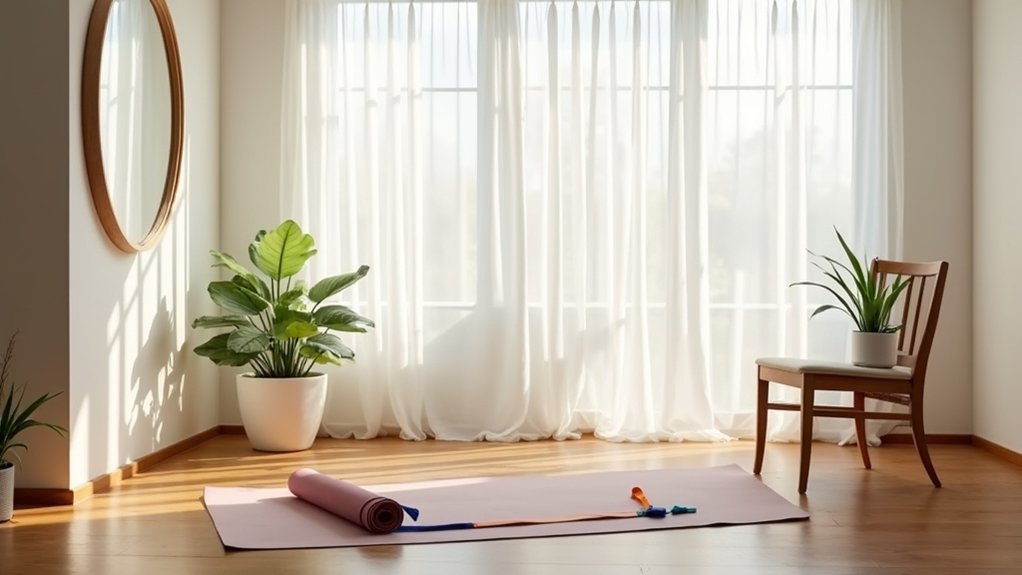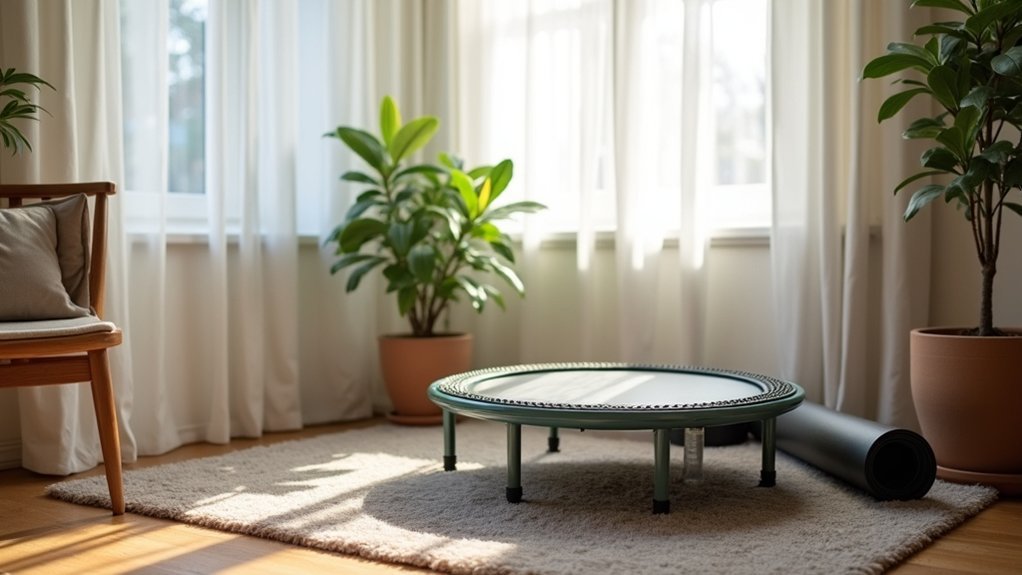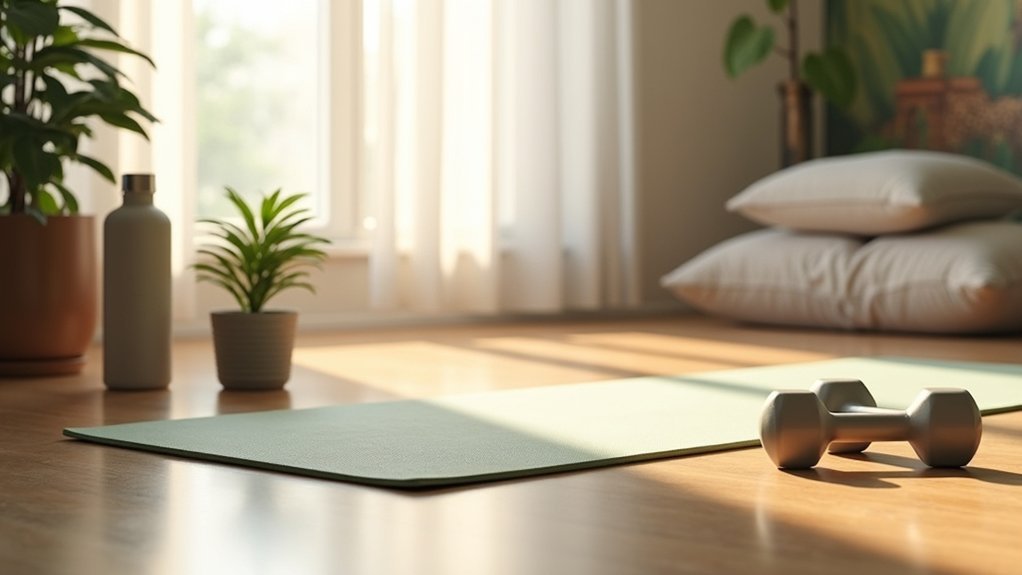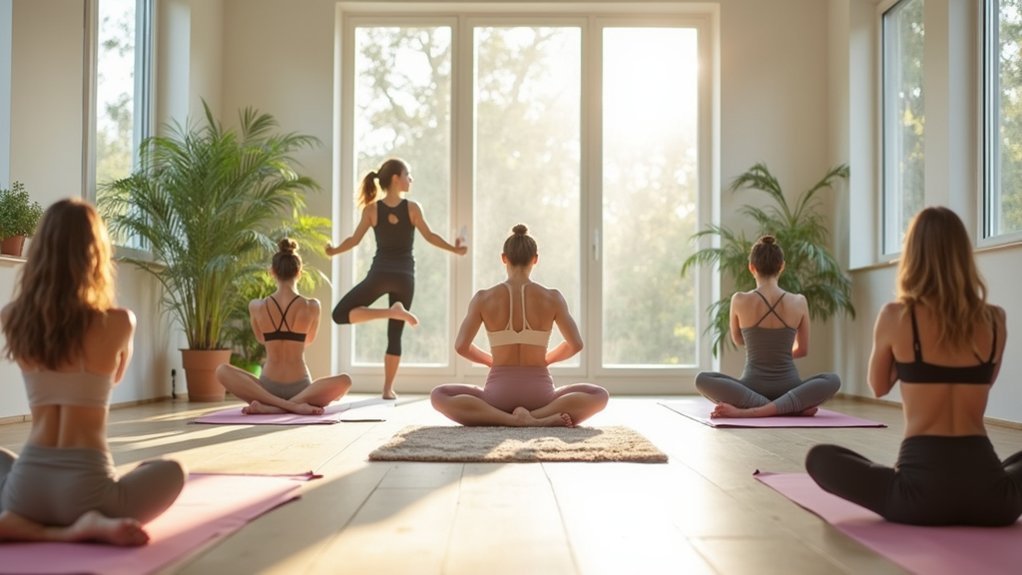For quiet indoor workouts, place your rebounder on rubber matting or carpet to absorb impact noise. Choose bungee cord systems over metal springs, and exercise during mid-morning or early evening hours. Wear low-profile shoes, focus on controlled movements, and use soundproofing mats beneath your equipment. Opt for low-impact exercises like planks, wall sits, and slow air squats. Inform neighbors about your workout schedule. These strategies will help maintain peace while you stay fit and active.
10 Tips for Quiet Indoor Workouts

Apartment dwellers and early risers face a common challenge: staying fit without disturbing others. You can minimize noise while maximizing results with these simple strategies.
First, invest in a cushioned mat to dampen floor impact during exercises. Wear low-profile, grippy footwear for stability without squeaks. Focus on controlled eccentric movements with 3-5 second lowering phases to reduce impact noise.
Choose equipment-free options like planks, wall sits, and controlled air squats performed slowly. Add resistance bands for lateral raises, seated rows, and glute bridges without creating floor vibrations. Incorporate yoga-based practices such as warrior poses and sun salutations for silent strength building. Consider trying a total-body circuit designed specifically for minimal noise that can be completed in just 30 minutes.
Structure your workout in 30-second intervals with brief rest periods, and select appropriate times of day to minimize disruption to neighbors.
Selecting Low-Impact Rebounders for Noise Reduction
You’ll find rebounders with bungee cord systems dramatically quieter than those with metal springs, making them ideal for apartment living.
Soundproofing your exercise area with foam mats or carpet underlayment can further reduce noise transmission to neighbors below.
When choosing between mini-trampolines and hardwood floor exercises, consider that the right rebounder actually produces less impact noise than jumping directly on wooden surfaces.
For optimal noise reduction, select models with high-quality steel frames that prevent squeaking and maintain stability during even the most vigorous workout routines.
Rebounders With Bungee Systems
When searching for a quiet workout solution that won’t disturb your household or neighbors, bungee rebounders stand out as an exceptional choice.
Unlike traditional spring systems that create metal-on-metal noise, latex or synthetic rubber bungees provide a virtually silent rebounding experience while offering several key advantages:
- Joint Protection – The softer, more controlled bounce reduces impact stress, making these rebounders ideal if you have joint issues or are recovering from injury.
- Easy Maintenance – Individual bungee cords can be replaced as needed, saving you money compared to spring system repairs.
- Smoother Experience – Bungee systems deliver a more fluid bounce that improves balance and coordination while still providing an effective workout.
Traditional spring rebounders often require regular oil application to reduce squeaking noises during use.
Look for models with adjustable firmness options to customize your rebounding experience.
Soundproofing Exercise Areas
Even the quietest rebounders benefit from thoughtful soundproofing strategies to minimize noise transmission throughout your living space.
Start by placing your rebounder on ½-¾” thick rubber matting or carpet padding to absorb vibrations before they reach the floor structure.
Focus on low-impact exercise routines—gentle bounces and controlled movements create considerably less noise than high-intensity jumps.
Keep your feet close to the mat and follow slower-paced workout guides whenever possible.
Schedule your sessions between 10 AM and 7 PM when neighbors are typically more tolerant of occasional noise.
For additional sound dampening, consider installing foam spring covers, vibration-isolating feet on rebounder legs, or even creating a raised plywood platform with an air gap to reduce resonance.
Wearing cushioned shoes instead of exercising barefoot can also help minimize impact sounds.
When performing basic bounce techniques, position your feet wider than hips with knees bent in a mini squat position to distribute impact more evenly and reduce noise from harder landings.
Mini-Trampolines vs. Hardwood
Choosing between a mini-trampoline and hardwood flooring for your quiet indoor workouts greatly impacts both noise levels and exercise effectiveness.
Mini-trampolines with arch-leg designs and rubber-capped feet considerably reduce sound transfer compared to hardwood’s direct impact forces.
When selecting a low-noise rebounder, prioritize these features:
- Bungee-based suspension systems eliminate the metallic spring noise while providing superior shock absorption.
- Heavy-duty frames (300+ lb capacity) minimize bounce-related vibrations and wobbling during intense sessions.
- Thick, tensioned mats muffle footfalls better than thin surfaces or hardwood impacts.
For maximum noise reduction, pair your mini-trampoline with a rubber undersurface mat and focus on controlled movements rather than explosive jumps—your downstairs neighbors will thank you. A mini trampoline typically requires minimal space with just 36 to 48 inches in diameter, making it suitable for most home environments.
Strategic Placement to Minimize Sound Transfer
The careful positioning of your workout equipment plays a crucial role in reducing noise transfer to adjacent spaces.
Keep vibration-heavy machines at least 3 feet from shared walls, and place your noisiest equipment in room corners where structural support is strongest.
Create a perimeter layout with all equipment facing inward, away from neighboring areas. Position cardio machines on interior walls rather than those shared with neighbors.
For weight training, set up racks over thick rubber mats or sand-filled platforms to absorb impact energy. Applying sound attenuation materials to your workout space can significantly enhance noise reduction and improve acoustics.
Consider using acoustic room dividers to contain noise within specific workout zones.
Strategically place bookshelves or other furniture against shared walls to add mass barriers.
This thoughtful arrangement, combined with proper flooring, can dramatically reduce sound leakage to surrounding spaces.
Optimal Times for Apartment Rebounding Sessions

While equipment placement forms the foundation of a quiet workout environment, timing your rebounding sessions plays an equally important role in maintaining neighborly harmony.
Consider the natural rhythm of your building when scheduling your bounces:
Tune into your building’s daily flow and bounce when your impact creates the least disruption.
- Mid-morning hours (9-11 AM) offer an ideal window after most neighbors have left for work but before those working from home begin important calls.
- Early evenings (5-7 PM) balance daytime noise tolerance with your post-work energy levels, while keeping sessions before dinner when most people aren’t settling in for the night.
- Weekend mid-days leverage higher ambient noise in apartment complexes when more residents are active and general noise tolerance increases.
For consistent exercise, try splitting your routine into 5-10 minute micro-sessions throughout the day rather than one extended bouncing period. This approach maximizes the accessibility benefits of rebounding while minimizing potential disturbances to neighbors.
Silence-Enhancing Accessories for Rebounders
Even the most sophisticated rebounders can benefit from noise-reducing accessories that transform your bouncing routine from potentially disruptive to practically silent.
Start with spring hooks to secure springs firmly in place, preventing rattling and squeaking during your workout. JumpSport offers specialized handle bars that provide stability while minimizing movement noise during intense rebounding sessions.
Consider upgrading to adjustable or bungee-type springs that offer smoother operation with less mechanical noise. High-quality trampoline mats absorb impact sounds while providing better bounce quality.
For thorough noise reduction, place a thick rubber mat underneath your rebounder to dampen vibrations that transfer to floors.
Don’t overlook enclosure nets – they not only enhance safety but also help contain noise by limiting vibration transfer.
Regular application of lubricants like WD-40 or longer-lasting silicone sprays on springs and joints will keep your rebounder operating quietly for years.
Impact-Absorbing Surface Modifications

Creating an impact-absorbing exercise area represents one of the most effective ways to minimize noise during home workouts.
Building a shock-absorbing workout zone is crucial for reducing noise transmission in residential exercise spaces.
Layered flooring systems dramatically reduce sound transmission by capturing impact forces before they travel through your structure. Consider implementing a zoned approach with softer surfaces where you perform high-impact movements. The proper gym flooring provides noticeable noise reduction, creating a less disruptive workout atmosphere for both you and your neighbors.
For quick and effective solutions:
- Interlocking foam tiles – Place these under your workout space, especially for plyometric exercises or weight training, creating a 5-10% compression zone that absorbs both impact and sound.
- Rubber underlayment – Install a 1/4-inch rubber mat beneath any existing exercise equipment to prevent vibration transfer to floors and walls.
- Hybrid combinations – Pair closed-cell foam bases with textured rubber tops for ideal sound dampening while maintaining necessary stability for dynamic movements.
Apartment-Friendly Rebounding Techniques
You’ll master quieter rebounding by standing with feet hip-width apart and keeping knees slightly bent for soft, controlled landings.
Focus on low-impact movements like basic bounces and surf twists that maintain cardiovascular benefits without excessive height or force.
Position your mini-trampoline in a corner and maintain centered weight distribution to minimize vibration transfer to neighbors below. Choosing a rebounder with elastic bungees instead of metal springs will significantly reduce noise while still providing excellent bounce quality for your workout.
Mini-Trampoline Silent Setup
Transforming your apartment into a fitness haven, mini-trampolines offer a perfect solution for quiet, effective workouts without disturbing your neighbors.
Look for models with sound-dampening features and foldable designs that easily store away when not in use.
To guarantee noise-free rebounding sessions:
- Place your trampoline on carpet or use a yoga mat underneath to absorb impact sounds
- Wear soft-soled shoes or socks to minimize footfall noise
- Practice controlled, lower bounces rather than high jumps to reduce vibration
Clear your workout space of breakable items and verify ceiling clearance before beginning.
These apartment-friendly rebounding workouts offer low-impact cardio while the trampoline mat absorbs over 80% of the impact on your joints.
Remember to secure the trampoline properly to prevent shifting during use.
With these precautions, you’ll enjoy the cardiovascular and strength benefits of rebounding while maintaining peaceful relations with those around you.
Low-Impact Bounce Patterns
While rebounding provides an excellent full-body workout, mastering low-impact bounce patterns guarantees you’ll maintain neighborly relations in apartment settings.
Focus on landing softly with slightly bent knees to absorb impact. Keep your core engaged and movements slow and controlled. Start with basic up and down bounces at minimal heights, then progress to small forward steps or gentle lateral movements. Practice closed chain movements where your feet remain connected to the rebounder mat for better stability and reduced noise.
For maximum noise reduction, maintain a lower stance throughout your session and limit excessive arm movements. Break complex exercises into smaller segments and pay attention to your body alignment.
Remember to breathe deeply for better concentration and adjust your bounce intensity based on your environment—softer in early mornings or late evenings when neighbors might be resting.
Stabilizing Without Noise
Beyond mastering bounce patterns, proper equipment stabilization forms the foundation of apartment-friendly rebounding. Place non-slip matting underneath your trampoline to prevent shifting during workouts while simultaneously muffling vibrations that travel through floors.
For ideal noise reduction:
- Set up on high-density foam flooring or carpeted areas instead of hardwood or concrete, which amplify impact sounds.
- Add rubberized leg caps to dampen contact between the rebounder frame and your floor.
- Install weighted base attachments to anchor the frame during vigorous routines.
Maintain pelvic-neutral alignment and practice low-abdominal scooping while rebounding to stabilize your core and prevent forceful landings. Incorporating gentle arm swings can enhance coordination while keeping movements controlled and quieter.
These techniques reduce both the intensity of your bounce and the sound that transfers to neighboring apartments.
Balancing Intensity With Noise Control
When exercising in shared living spaces, maintaining workout intensity while minimizing noise presents a unique challenge. You’ll need strategic modifications to your routine.
Replace high-impact movements with alternatives like power jacks instead of jumping jacks, and step-back plank jacks rather than burpees. Focus on compound exercises such as squat-to-reach or lunges with rotation to efficiently engage multiple muscle groups quietly. Incorporating quiet burpees that eliminate jumping maintains intensity while keeping noise levels down.
Modify your movements, not your results—power jacks and compound exercises deliver intensity without the noise.
Consider adjusting your interval strategy with 45-second work periods followed by 15-second rests, or try EMOM formats with 5-8 quiet exercises.
Equipment choices matter too—opt for resistance bands over machines and use yoga mats to dampen footfall sounds.
For cardio intensity without the racket, try arm-driven movements like shadow boxing or controlled tempo variations that keep your heart rate elevated silently.
Creating a Sound-Dampening Workout Zone
Transforming your living space into a quiet workout sanctuary requires strategic sound management beyond simply choosing low-impact exercises.
Start with the foundation by investing in thick rubber mats (1-2 inches) that can reduce impact vibration by up to 60% and cut noise by 21-38 decibels, depending on the product.
For thorough noise control:
- Layer your approach – combine rubber flooring with underlayment to maximize shock absorption and prevent vibrations from transferring to your neighbors.
- Address the entire room – add fabric-wrapped wall panels and ceiling treatments to reduce echoes and absorb airborne sounds.
- Seal the perimeter – install door sweeps, weatherstripping, and heavy curtains to prevent sound from escaping your workout zone. Rubber-coated weights provide additional noise reduction when metal equipment cannot be avoided, creating a quieter lifting experience with minimal disruption.
Neighbor-Conscious Rebounding Routines
Rebounding workouts offer a fantastic low-impact fitness option, but they can create noise concerns in multi-unit buildings. Invest in a bungee-style rebounder with silent springs to greatly reduce noise compared to traditional metal springs.
Time your workouts thoughtfully, avoiding early mornings or late evenings when neighbors are likely resting. Place your rebounder on sound-absorbing mats to minimize vibration transfer through floors.
Consider incorporating more HIIT-style routines that keep workout duration shorter while maximizing cardiovascular benefits. Models like the Fit Bounce Pro II offer quiet performance while still providing an effective workout that burns calories comparable to running. Modify your rebounding style by focusing on gentler, controlled movements rather than high jumps. Core-strengthening exercises and balance work can be just as effective without the noise.
For added consideration, briefly inform your neighbors about your routine schedule—this simple courtesy can prevent potential conflicts.
Space-Saving Storage Solutions for Rebounders
Despite their fitness benefits, rebounders can quickly become space-consuming obstacles when not in use. Maximizing your living space requires strategic storage approaches that keep your rebounder accessible yet unobtrusive.
Consider these vertical storage options that minimize footprint:
- Mount wall racks or hooks to keep your rebounder off the ground and free up valuable floor space in your workout area.
- Invest in rebounders with foldable frames or patented arched legs that can be tucked under furniture or stacked safely against walls.
- Add mobility with rolling carts or retractable caster kits that allow you to quickly relocate your rebounder between rooms without disassembly.
For apartment dwellers, behind-door storage or integrated placement with existing shelving units creates dual-purpose spaces that maintain both functionality and aesthetics. A stylish alternative is disguising your mini trampoline as an ottoman furniture piece, which offers both exercise convenience and elegant living room decor.
Frequently Asked Questions
Can I Continue My Workout if Neighbors Complain Anyway?
While you can exercise your rights, continuing workouts after complaints may lead to legal issues. Try negotiating workout times, implementing soundproofing, or considering gym memberships to maintain both your fitness and neighborhood peace.
How Do I Measure if My Workout Is Actually Quiet Enough?
Use a decibel meter app to measure noise levels during exercises. You’ll want to stay below 60 dBA for apartments. Record at different positions and try dropping equipment to test impact noise reduction.
What Quiet Exercises Deliver the Highest Calorie Burn?
You’ll burn the most calories with modified HIIT workouts using quiet alternatives like mountain climbers, shadowboxing, plank variations, and resistance band exercises. Tabata-style circuits also maximize calorie burn while keeping noise minimal.
Will Foam Insulation Tiles Damage Rental Apartment Floors?
Foam insulation tiles generally won’t damage rental floors if you use protective layers underneath. You’ll need to distribute weight evenly, avoid sharp furniture, and remove them carefully to prevent scratches or marks.
Can Morning Yoga Routines Replace High-Intensity Cardio Workouts?
Morning yoga can’t fully replace high-intensity cardio’s calorie burn, but HIIC-Yoga (tempo-based) offers comparable cardiometabolic benefits. You’ll gain flexibility and stress reduction with yoga while burning fewer calories than traditional cardio workouts.
In Summary
With these 10 tips, you’ll transform your rebounder workouts into neighbor-friendly fitness sessions. You’ve learned how to reduce noise, optimize your space, and time your bouncing strategically. By implementing sound-dampening techniques and choosing the right equipment, you’re set for effective, quiet exercise. Remember, considerate rebounding isn’t just about noise control—it’s about creating a sustainable indoor fitness routine that keeps both you and your neighbors happy.





Leave a Reply